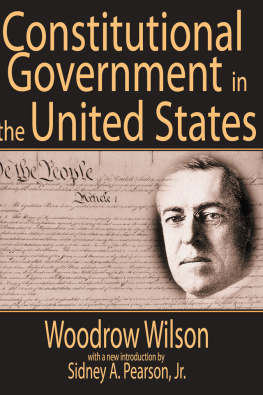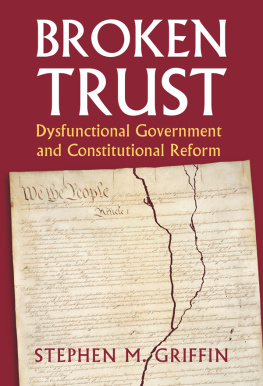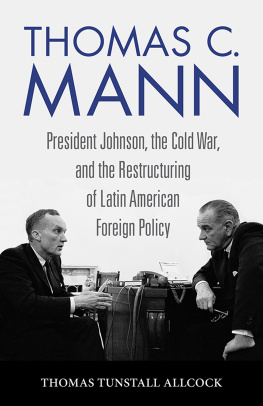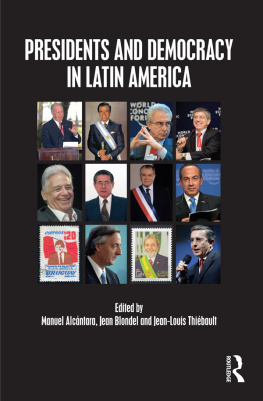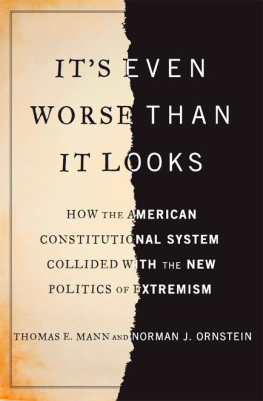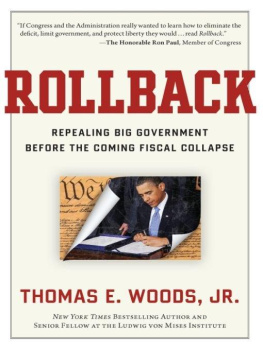ITS EVEN WORSE
THAN IT LOOKS
ITS EVEN WORSE
THAN IT LOOKS
HOW THE AMERICAN
CONSTITUTIONAL SYSTEM
COLLIDED WITH THE NEW
POLITICS OF EXTREMISM
T HOMAS E. M ANN AND N ORMAN J. O RNSTEIN

A MEMBER OF THE PERSEUS BOOKS GROUP
NEW YORK
Copyright 2012 by Thomas E. Mann and Norman J. Ornstein
Published by Basic Books,
A Member of the Perseus Books Group
All rights reserved. Printed in the United States of America. No part of this book may be reproduced in any manner whatsoever without written permission except in the case of brief quotations embodied in critical articles and reviews. For information, address Basic Books, 387 Park Avenue South, New York, NY 10016-8810.
Books published by Basic Books are available at special discounts for bulk purchases in the United States by corporations, institutions, and other organizations. For more information, please contact the Special Markets Department at the Perseus Books Group, 2300 Chestnut Street, Suite 200, Philadelphia, PA 19103, or call (800) 810-4145, ext. 5000, or e-mail .
Design and production by Eclipse Publishing Services
A CIP catalog record for this book is available
from the Library of Congress.
E-book ISBN: 978-0-465-03136-8
10
To our terrific families who keep both of us grounded
Sheilah, Stephanie, and Ted, Suzanne and Leonardo;
and Judy, Matthew, Danny, and Harvey
And in memory of our dear friend and
prescient scholar, Austin Ranney
Contents
O n January 26, 2010, the Senate voted on a resolution to create an eighteen-member deficit-reduction task force with teeth, a fast-track procedure to bring a sweeping plan to solve the U.S.s debt problem straight to the floor for an up-or-down vote. The resolution was coauthored by Democrat Kent Conrad of North Dakota and Republican Judd Gregg of New Hampshire, and had substantial bipartisan support, including from Republican leaders like John McCain and Mitch McConnell. The latter did not cosponsor the resolution but had said eight months earlier on the Senate floor:
We must address the issue of entitlement spending now before it is too late. As I have said many times before, the best way to address the crisis is the Conrad-Gregg proposal, which would provide an expedited pathway for fixing these profound long-term challenges. This plan would force us to get debt and spending under control. It deserves support from both sides of the aisle. The administration
But on January 26, the Senate blocked the resolution. Fifty-three senators supported it, but it could not garner the sixty votes needed to overcome a Republican filibuster. Among those who voted to sustain the filibuster and kill the resolution were Mitch McConnell and John McCain. McCain was joined in opposition by six other original cosponsors, all Republicans. Never before have cosponsors of a major bill conspired to kill their own idea, in an almost Alice-in-Wonderland fashion. Why did they do so? Because President Barack Obama was for it, and its passage might gain him political credit.
Fred Hiatt, the opinion editor of the Washington Post, wrote of McConnells change of position, No single vote by any single senator could possibly illustrate everything that is wrong with Washington today. No single vote could embody the full cynicism and cowardice of our political elite at its worst, or explain by itself why problems do not get solved. But heres one that comes close.
Six years ago, we wrote The Broken Branch, which sharply criticized the Congress for failing to live up to its responsibilities as the first branch of government. Based on four decades of watching Congress, ours was a sympathetic perspective, one that reflected our appreciation of the inherent messiness of the legislative process within the constitutional system. Reconciling diverse interests and beliefs in Americas extended republic necessarily involves adversarial debates and difficult negotiations.
But there was no denying the impact of broad changes in Americas wider political environmentmost importantly the ideological polarization of the political partieson how Congress went about its work. We documented the demise of regular order, as Congress bent rules to marginalize committees and deny the minority party in the House opportunities to offer amendments on the floor; the decline of genuine deliberation in the lawmaking process on such important matters as budgets and decisions to go to war; the manifestations of extreme partisanship; the culture of corruption; the loss of institutional patriotism among members; and the weakening of the checks-and-balances system.
While we observed some improvement after the Democrats regained control of Congress in the 2006 midterm elections, the most problematic features of the system remained. We thought them unlikely to abate absent a major national crisis that inspired the American public to demand that the warring parties work together. America got the crisisthe most serious economic downturn since the Great Depressionand a pretty clear signal from the voters, who elected Barack Obama by a comfortable margin and gave the Democrats substantial gains in the House and Senate. What the country didnt get was any semblance of a well-functioning democracy. President Obamas postpartisan pitch fell flat, and the Tea Party movement pulled the GOP further to its ideological pole. Republicans greeted the new president with a unified strategy of opposing, obstructing, discrediting, and nullifying every one of his important initiatives. Obama reaped an impressive legislative harvest in his first two years but without any Republican engagement or support and with no apparent appreciation from the public. The anemic economic recovery and the pain of joblessness and underwater home mortgages led not to any signal that the representatives ought to pull together, but rather to yet another call by voters to throw the bums out. The Democrats devastating setback in the 2010 midterm elections, in which they lost six Senate seats and sixty-three in the House, produced a Republican majority in the House dominated by right-wing insurgents determined to radically reduce the size and role of government. What followed was an appalling spectacle of hostage takingmost importantly, the debt ceiling crisisthat threatened a government shutdown and public default, led to a downgrading of the countrys credit, and blocked constructive action to nurture an economic recovery or deal with looming problems of deficits and debt.
In October 2011, Congress garnered its lowest approval rating (9 percent) in polling history. Public trust in the governments capacity to solve the serious problems facing the country also hit record lows. Almost all Americans felt their country was on the wrong track and were pessimistic about the future. The public viewed both parties negatively, and President Obamas job approval rating was mired in the forties. The widespread consensus was that politics and governance were utterly dysfunctional. In spite of the perilous state of the global economyand with it the threat of another financial crisis and recessionno one expected the president and Congress to accomplish anything of consequence before the 2012 election.
Paradoxically, the publics undifferentiated disgust with Congress, Washington, and the government in general is part of the problem, not the basis of a solution. In never-ending efforts to defeat incumbent officeholders in hard times, the public is perpetuating the source of its discontent, electing a new group of people who are even less inclined to or capable of crafting compromise or solutions to pressing problems. We have been struck by the failure of the media, including editors, reporters, and many expert commentators, to capture the real drivers of these disturbing developments, and the futility of efforts by many nonpartisan and bipartisan groups to counter, much less overcome, them. We write this book to try to clarify the source of dysfunctional politics and what it will take to change it. The stakes involved in choosing who will lead us in the White House, the Congress, and the Supreme Court in the years ahead are unusually high, given both the gravity of the problems and the sharper polarization of the parties.


